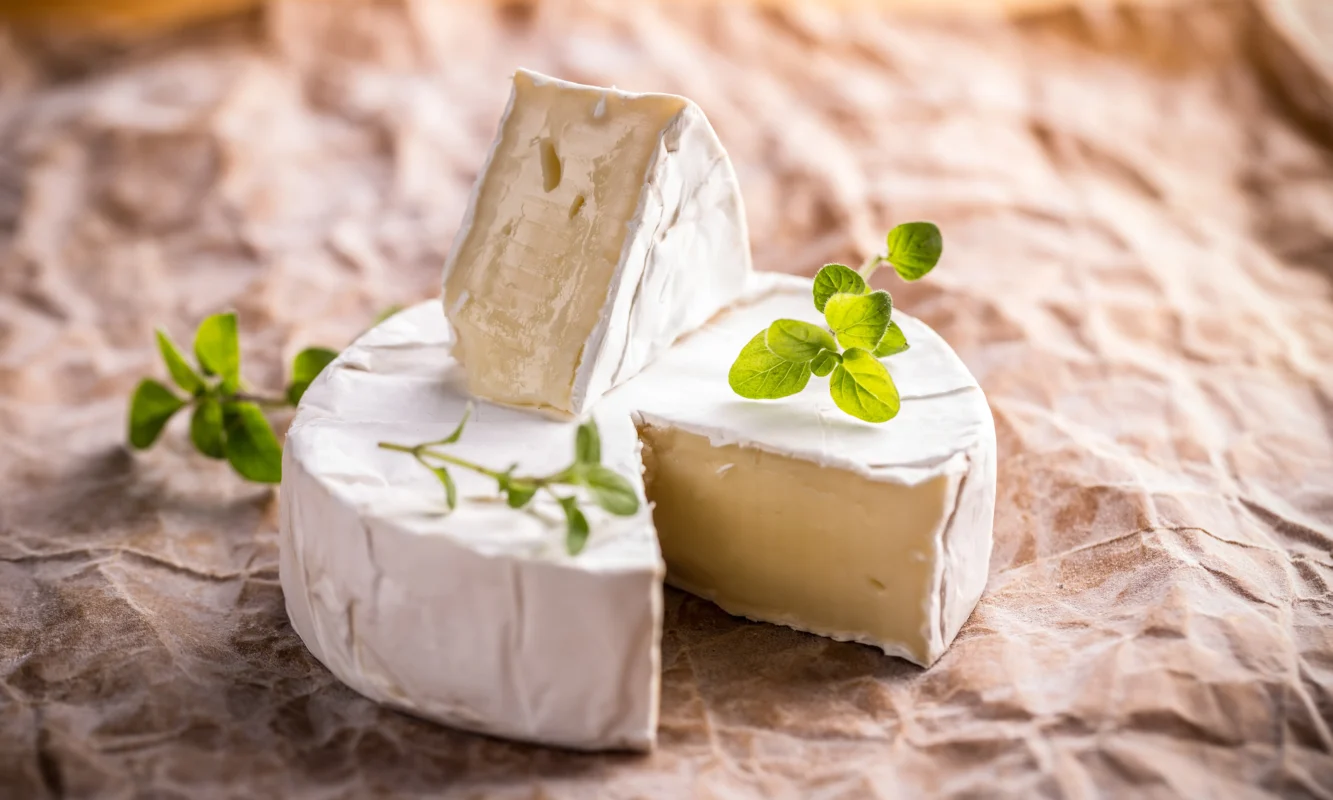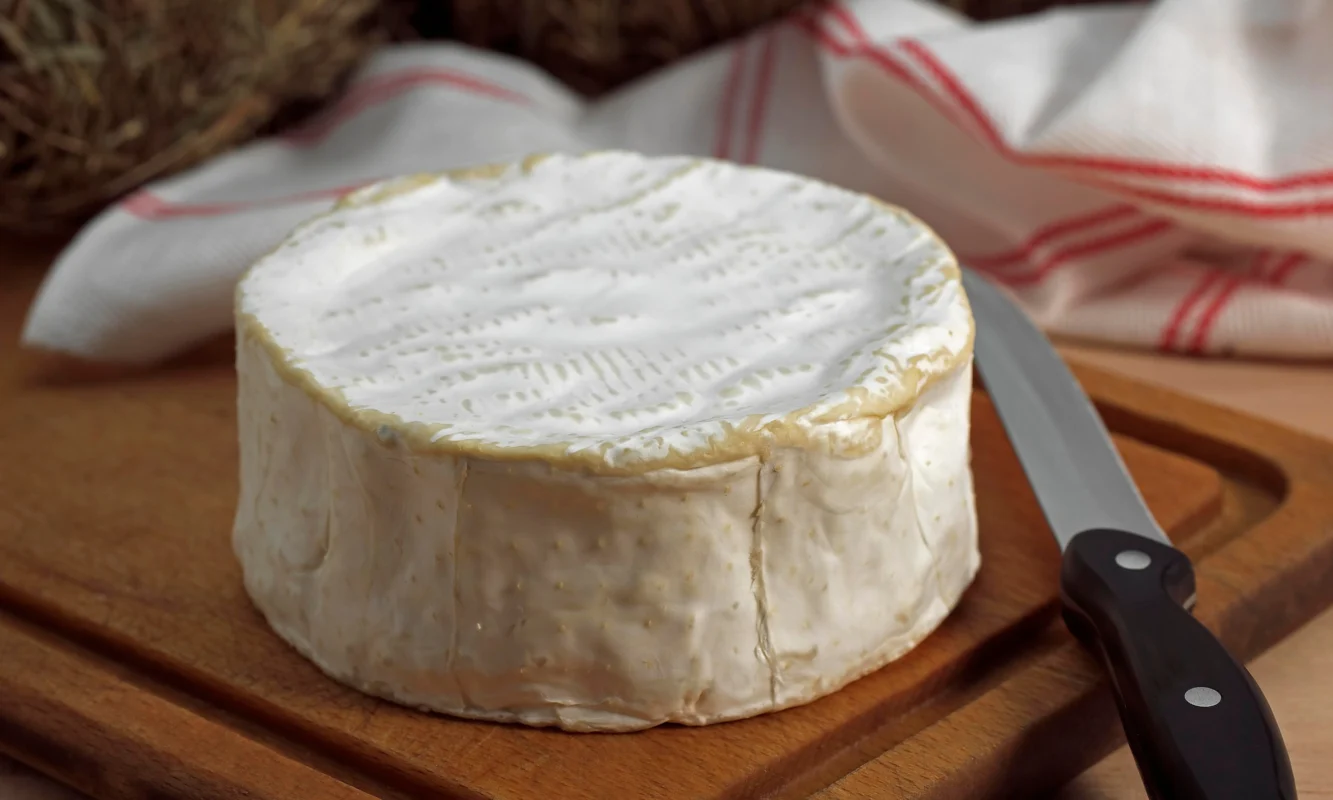French cuisine and culture wouldn’t be the same without cheese. France boasts a diverse and rich selection of cheeses, each with its own unique flavour and history. Let’s explore some of the most famous regional varieties and discover what makes French cheese so special.
Regional Cheese Varieties
1. Normandy


Camembert
Camembert, created in the late 18th century, is a soft, creamy cheese with a white, edible rind. Its flavour ranges from mild to pungent as it ages. Camembert is an iconic symbol of French cheese-making. It’s often enjoyed with crusty bread and a glass of Normandy cider. The cheese is best known for its rich, buttery texture and a slight mushroom-like taste from its rind.
Pont-l’Évêque
Pont-l’Évêque is one of the oldest Norman cheeses, dating back to the 12th century. This soft, square-shaped cheese has a strong smell but a smooth, creamy taste. It pairs well with a slice of apple or pear and a glass of Calvados. Its slightly tangy flavour and rich aroma make it a favourite for those who love strong cheeses.
Livarot
Known as “The Colonel” due to the stripes on its rind, Livarot is a pungent, washed-rind cheese. It has a spicy and earthy flavour, reflecting its long history in Normandy. Try it with robust red wines or a dark beer. The cheese’s texture is dense and slightly sticky, making it a rich addition to any cheese platter.
2. Burgundy


Époisses
This washed-rind cheese is famous for its strong smell and smooth, rich interior. Napoleon reportedly loved Époisses, which pairs well with red Burgundy wine. Its production involves washing the cheese in marc de Bourgogne, a local brandy, giving it a distinctive character. The cheese has a creamy, almost liquid interior that offers a deeply savoury taste with hints of sweetness.
Brillat-Savarin
Named after the famous French gastronome, this triple-cream cheese is rich and decadent. It has a buttery texture and a slightly tangy flavour, making it a favourite among cheese lovers. Enjoy it with Champagne or fresh berries. Its luxurious, melt-in-the-mouth quality is perfect for special occasions or indulgent treats.
3. Auvergne


Bleu d’Auvergne
This blue cheese, created in the mid-19th century, has a moist, creamy texture and a strong, spicy flavour. It’s made from cow’s milk and aged in humid cellars. Pair it with sweet wines like Sauternes or port to balance its intensity. Its veins of blue mould add a sharp tanginess, which complements the creamy base.
Saint-Nectaire
Produced in the Auvergne region for centuries, Saint-Nectaire is a semi-soft cheese with a nutty, earthy taste. It has a distinctive, creamy texture and is often enjoyed with rustic bread. A glass of Beaujolais complements its flavour well. The cheese’s history dates back to the 17th century, and it’s known for its supple texture and complex flavour profile.
Cantal
One of France’s oldest cheeses, Cantal is a firm, cow’s milk cheese. It has a tangy, buttery flavour that becomes more pronounced with age. Cantal is versatile, perfect for melting in dishes or serving with apples and walnuts. The cheese can be young (Jeune), semi-mature (Entre-Deux), or mature (Vieux), each offering different taste experiences.
4. Provence


Banon
Banon is a soft cheese wrapped in chestnut leaves and tied with raffia. It has a tangy, slightly spicy taste, reflecting the herbs and plants of Provence. Pair it with a rosé wine from the region for a delightful experience. The chestnut leaves impart a subtle earthy flavour, enhancing the cheese’s natural spiciness.
Picodon
This small, round goat cheese has a firm texture and a strong, slightly peppery flavour. It’s often enjoyed with a glass of local wine and a drizzle of honey. Picodon is typically aged for several weeks, allowing its flavour to develop fully. Its name means “spicy” in the local dialect, and it delivers a bold, tangy taste.
Many believe French fries originated in France, but their true history is debated. Learn about the origin of French fries.
5. Alsace


Munster
Named after the town of Munster in Alsace, this strong-smelling, soft cheese is made from cow’s milk. It has a rich, tangy taste and is often flavoured with caraway seeds. Enjoy Munster with a crisp Alsatian white wine and rye bread. The cheese is known for its potent aroma and creamy, smooth texture.
6. Savoy


Beaufort
Known as the “Prince of Gruyères,” Beaufort is a hard, cow’s milk cheese with a smooth, creamy texture and a fruity, nutty flavour. It’s often used in fondue and pairs well with a glass of white wine from the region. Beaufort is aged in mountain caves, which contribute to its complex, slightly sweet taste.
Reblochon
This soft, washed-rind cheese has a creamy interior and a nutty, slightly fruity taste. It’s famously used in the Savoyard dish tartiflette. Reblochon pairs beautifully with white wines like Roussette de Savoie. The cheese’s name means “re-milking,” referring to its historical production method, which adds depth to its flavour.
Tomme de Savoie
This semi-soft cheese has a grey, mouldy rind and a firm, creamy interior. It has a mild, earthy flavour and pairs well with crusty bread. A glass of red wine, such as Gamay, complements Tomme de Savoie perfectly. The cheese’s rustic appearance and gentle taste make it a versatile addition to any meal.
Want to Explore French Culture?
Join our courses to enjoy the rich culture of France while mastering the language!
7. Corsica


Brocciu
Made from sheep or goat’s milk, Brocciu is a fresh, white cheese similar to ricotta. It’s a staple in Corsican cuisine and can be eaten fresh or aged. Enjoy Brocciu with fresh herbs, olive oil, and a slice of rustic bread. The cheese is often used in local dishes, adding a creamy, light texture.
8. Loire Valley


Crottin de Chavignol
This small, goat cheese has a firm texture and a nutty, tangy flavour. It’s often enjoyed with a glass of Sancerre wine. Crottin de Chavignol is delicious when slightly aged, developing a more pronounced flavour. The cheese’s small size and distinctive taste make it a popular choice for cheese boards.
Valençay
This pyramid-shaped goat cheese has a grey, mouldy rind and a creamy, tangy interior. It pairs well with white wines from the Loire Valley. Legend says the cheese was originally shaped like a pyramid, but Napoleon had the top cut off after his defeat in Egypt. Valençay’s unique shape and story add to its charm.
French cuisine is famous for its sweet treats, and these 20 classic French desserts offer a delightful taste of tradition and indulgence.
9. Pyrénées


Ossau-Iraty
This sheep’s milk cheese from the Basque region has a firm, oily texture and a nutty, fruity flavour. It’s often enjoyed with black cherry jam. Ossau-Iraty pairs well with a robust red wine or a slice of country bread. The cheese’s rich history and traditional production methods give it a unique flavour.
Roquefort
One of the world’s most famous blue cheeses, Roquefort is made from sheep’s milk and aged in limestone caves. It has a creamy texture and a strong, tangy flavour. Pair it with sweet wines like Sauternes or fresh figs. Roquefort’s distinctive blue veins and intense taste make it a standout choice for blue cheese enthusiasts.
Pairing French Cheeses
Pairing French cheeses with the right accompaniments can enhance their flavours. For wines, consider red Burgundy with Époisses, Sancerre with Crottin de Chavignol, and a robust red wine with Roquefort. Fruits like apples, pears, and figs pair well with many cheeses, providing a sweet contrast. Nuts such as walnuts and almonds also complement the rich, creamy textures. Fresh baguettes and rustic bread are traditional choices, while crackers can add a crunchy contrast.
Cheese Etiquette and Serving Tips
When serving French cheeses, remember a few key tips. For the cheese to taste its best, serve it room temperature. Cut cheese from the centre outwards, ensuring each piece has a bit of rind and interior. A cheese course typically follows the main course but before dessert, allowing guests to savour the flavours.
Conclusion
French cheeses are a testament to the country’s rich culinary heritage. Each region offers unique varieties that reflect local traditions and landscapes. Explore and enjoy the diverse world of French cheeses, and don’t forget to check out our other blogs about France and the French language.
Next, check our article on Types of French Cheese to learn all about cheeses in France.
Frequently Asked Questions
Q: What is France the King of cheeses?
Ans: France is often called the “King of Cheese” due to its vast variety of cheeses. With over 1,000 different types, France’s cheese-making tradition is rich and diverse. Each region has its own specialties, making French cheese a central part of its culinary culture.
Q: What is the most consumed cheese in France?
Ans: Camembert is one of the most consumed cheeses in France. Its creamy texture and mild flavour make it a favourite among the French. It’s enjoyed in many ways, from simple sandwiches to baked Camembert with herbs.
Q: What is the rarest French cheese?
Ans: One of the rarest French cheeses is Le Vacherin Fribourgeois d’Alpage, which is made exclusively in the Swiss canton of Fribourg, but can be found in limited quantities in France. This cheese is produced only in the summer months in small mountain dairies and is known for its unique, creamy texture and robust flavor.
Q: What is Napoleon cheese?
Ans: Napoleon cheese refers to Époisses, a strong-smelling, soft cheese from Burgundy. It was reportedly one of Napoleon’s favourite cheeses, and it pairs well with robust red wines. Its pungent aroma and rich flavour make it a distinctive choice for cheese lovers.





